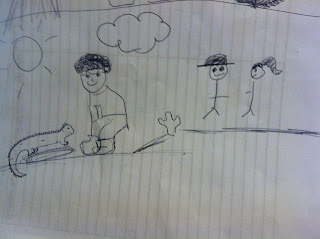Drawing
a scientist might have gone differently for me than it went for most people. I had talked earlier in the day to one of the
students who spent her winter break in Costa Rica with the biology department,
and consequently the idea of scientists going out into the world to test
hypotheses, chase animals, and collect data was fresh in my mind when I drew my
two scientists. The first drawing
features my friend who spent time in Costa Rica. She’s outside at night with a net, looking to
catch some bats. She is wearing some
outdoorsy gear: shorts, a t-shirt, and hiking boots, and is pointing excitedly
at some sort of horribly mutated bat (the victim of my sub-par art
skills). This drawing of my friend speaks to some of my
attitudes about science and who can “do science”. I think that scientific aptitude is not
limited by a degree, and is not determined by the letters preceding one’s
name. My friend is one of the most scientifically
literate, inquisitive people out there, and I think that drawing her on her
Costa Rica trip was my way of voicing that idea.
This bat may or may not have been exposed to radiation, causing its wings to took strikingly like muscle-y arms.
I drew a
second scientist because I wanted to draw a more “traditional” scientist. This is also an illustration from that Costa
Rica trip. Yes, that is Dr. Robert
Dawley looking at an iguana and in danger of falling on a cactus (which, I was
told, he did fall on after looking at the iguana). This drawing of a scientist might look a
little bit more like the “traditional” idea of what a scientist might be: he
has curly hair, glasses, he might be a little clumsy (as suggested by the
cactus), and is absorbed in his work. But,
he’s also out in the hot Costa Rican sun and teaching others about his
scientific focus, so I think that this drawing of a scientist still differs
from the norm.
Dr. Dawley and an iguana. He looks like our more traditional conception of a scientist because
his hair is, in reality, a little crazy. I wish you could see the iguana in greater detail, because it is a triumph.
My good
friend Will also drew a scientist for me.
His drawing was astoundingly detailed, and much better than my awful “artwork”. His drawing featured a man in his
mid-thirties standing in a lab, holding an Erlenmeyer Flask, looking thoughtful
and surrounded by microscopes, machines, and chemicals. The scientist is young and handsome-looking,
which defies conventional beliefs about scientists, but he is also looking
aloof and pensive, which I think reflects some more “traditional” ideas about
science. When I asked Will what the
different machines he had drawn were, he said “I’m really not sure, I thought it
looked cool.” I think that Will’s
drawing speaks to some attitudes that we hold about science and scientists: that
science is “cool”, but we’re not exactly sure about the science and the
mechanics involved. When most people think about scientists, they
might be thinking of a social conception of what a scientist does and what he
or she looks like. Will is a humanities
major, and so has had one science class in his time here. He has not had that much exposure to
scientists at Ursinus, and I think this has caused him to lean more heavily on
society’s conception of what a scientist might look like.
I think
that’s the crux of the problem with society’s mistrust of science: a lack of
exposure. We have trouble seeing
scientists as regular people who put their pants on one leg at a time (until
someone invents a contraption to streamline pants wearing, that is), because we
don’t see much of scientists in the public sphere. When we hear about a scientific discovery, we
tend to hear more about the discovery itself and what it means than about the
scientists behind it. For example, many
people are talking about the baby that a research team from John’s Hopkins, the
University of Mississippi, and UMass that may have cured a baby infected with
HIV. Unfortunately, people don’t take
the time to learn that Dr. Deborah Persaud, the lead author of the paper is a working
mom with kids just like many women in America and around the globe. She has to worry about whose day it is to
pick the kids up at daycare (in fact, according to a news article, she once
almost missed a party given in her honor because she was convinced it was her
day to pick up her toddlers from daycare), she has to do her taxes, and she
reads gossip magazines.
We as a
nation need to make the notion that scientists are regular people more
accessible to everyone. By perpetuating the
stereotype that scientists (and by extension, science) are intimidating, we are
making it more difficult for young people to overcome their reservations about
going into the sciences. As science
journalists, it should be our responsibility to make sure that science and scientists are presented as interesting
and accessible rather than distant, unfeeling, and cold. I would strive to do this by finding
relatable personal characteristics for the scientists I interview for
writing. I want to present not only the
science, but the human behind that science; maybe they tell a good joke or have
a great collection of coffee mugs or you can hear the excitement in their voice
as they talk about their research. The
more characteristics that readers can identify with, the greater the chance
that they will pursue their interests further and consider science as something
within reach instead of something reserved for those with an advanced degree.


No comments:
Post a Comment